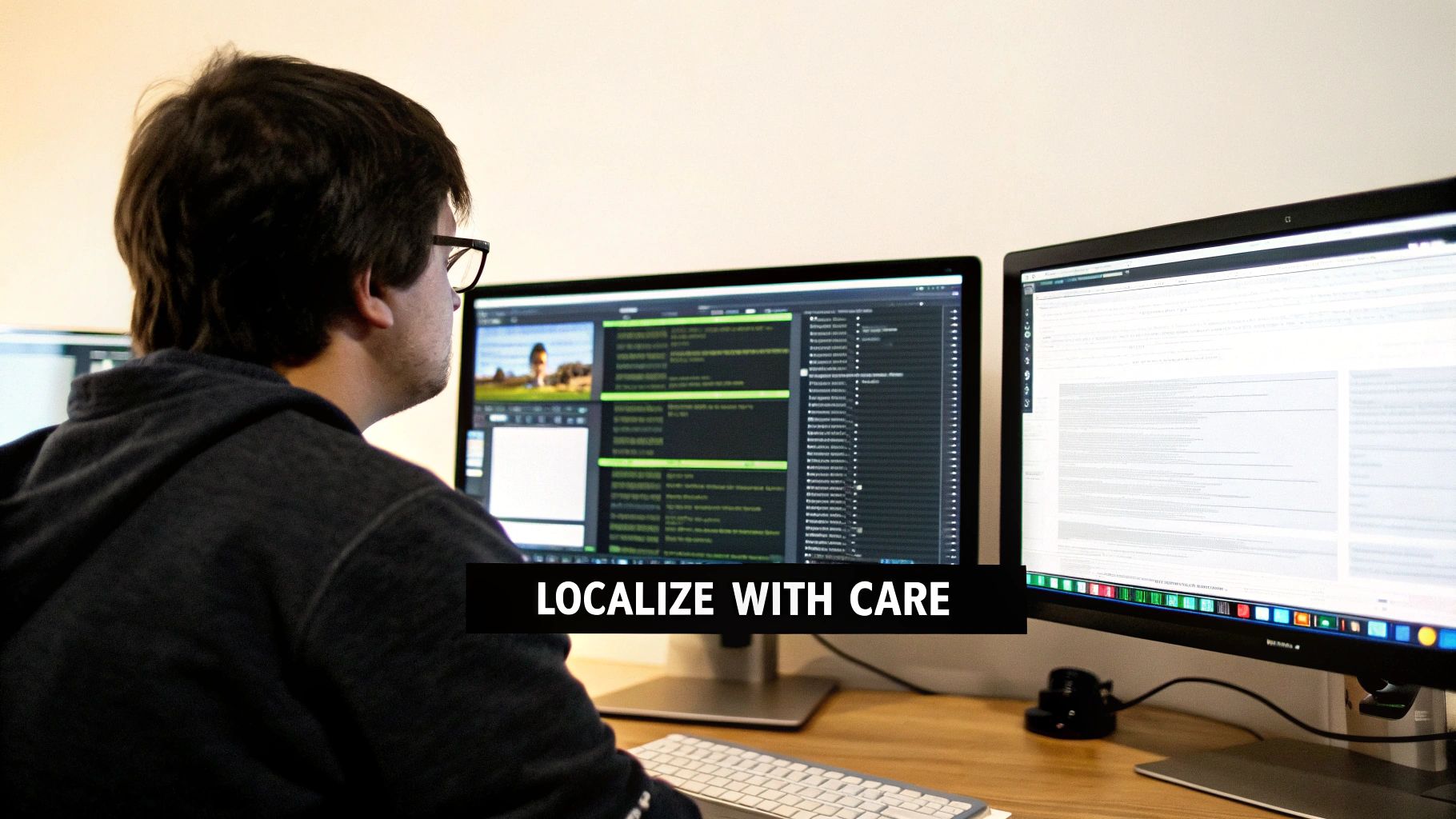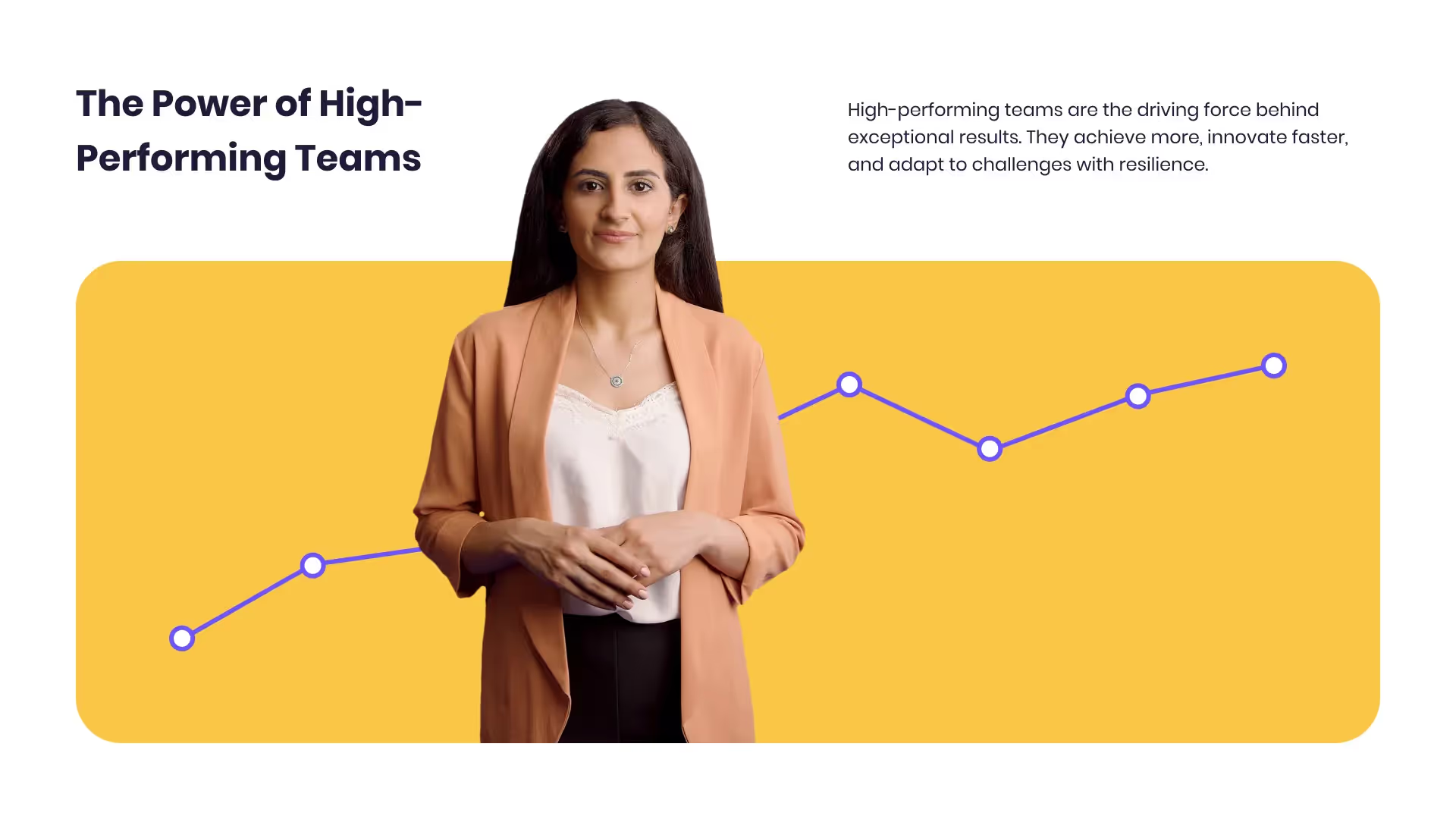.avif)
Want a personalised avatar?
Instant Avatars can be recorded using your phone or camera, and created in under a minute. These avatars are quick and easy to create, and they keep your original background and movements.

How To Translate A Video From Spanish to English: The Modern Workflow


You need to translate a video from Spanish to English. You could go the old-school route, juggling freelance translators, voice actors, and video editors. Or, you could leverage AI to get it done faster and more affordably. But the real question is: how do you get professional, engaging results without the traditional headaches?
The strongest argument is for a modern, integrated approach. Instead of treating translation as a series of separate, disconnected tasks, you can use a powerful AI video platform like Colossyan to unify the entire workflow. It acts as the central hub where your existing tools and assets come together. You start with your original Spanish script or video, let AI handle the heavy lifting of translation and voice generation, and then use your team’s expertise for the crucial final polish. This hybrid strategy delivers speed and efficiency without sacrificing the quality that builds trust with a new audience.
Why Translate Spanish Videos for English Audiences

Turning your Spanish videos into English isn't just about swapping one language for another. It's a strategic business move that unlocks enormous potential for growth and engagement.
By breaking the language barrier, you gain direct access to some of the world's most lucrative consumer markets, including the U.S., the U.K., and Canada. This isn't just about increasing view counts; it's about connecting with audiences that have significant purchasing power and influence.
Furthermore, multilingual content dramatically enhances your brand's credibility and SEO. Each English video becomes a new, indexable asset for search engines, effectively doubling your online visibility. It’s a powerful method for building a global footprint and positioning your company as a forward-thinking international player.
Tap Into a High-Demand Market
The demand for localized video content is not just growing; it's exploding. From corporate training and marketing campaigns to social media content, audiences now expect - and prefer - content delivered in their native language.
The market data confirms this shift. The global AI video translation market was recently valued at USD 2.68 billion. Projections show it skyrocketing to USD 33.4 billion by 2034, driven by a massive compound annual growth rate (CAGR) of 28.7%. You can explore the full market analysis of AI video translation to see the data for yourself.
This is a fundamental change in content strategy. Businesses that embrace efficient translation workflows now are positioning themselves for sustained success. The ability to translate a video from Spanish to English has evolved from a "nice-to-have" luxury to a competitive necessity.
Modernize Your Translation Workflow
Not long ago, video translation was a logistical nightmare. It was a slow, expensive process that meant juggling multiple vendors for transcription, translation, and audio-video synchronization. The turnaround times were brutal, and the costs were unpredictable.
Thankfully, AI-powered platforms have completely transformed this outdated model. The core argument for using a tool like Colossyan is that it centralizes this fragmented process, making high-quality video translation accessible, affordable, and incredibly fast. It’s not about replacing your tools, but empowering them.
Instead of wrestling with different services, Colossyan allows you to manage the entire project in one place:
- Auto-Translation: Instantly convert your Spanish script into accurate English text.
- AI Voice Generation: Select from a vast library of natural-sounding English voices to create a professional dub.
- Avatar Presenters: Generate a completely new video with a realistic AI avatar delivering your translated script, perfect for localizing training content.
This new workflow takes a complex technical challenge and simplifies it into a streamlined creative process. A project that once required weeks of coordination can now be completed in hours. This efficiency frees up your team to focus on high-level strategy and growth, rather than getting bogged down in logistical details. To see how this fits into your overall content strategy, check out our deep dive into why video content is a must for modern business strategy.
So, you're ready to translate a Spanish video into English. Your first big decision is how you'll deliver that translation. This isn't just a technical choice; it's a strategic one that shapes how your audience will experience your content. The two main roads you can take are subtitles and AI dubbing, and they serve very different goals.
Subtitles: The Classic Approach
Subtitles are what most people think of first. You keep the original Spanish audio and simply overlay the English translation as text at the bottom of the screen.
This is a fantastic way to maintain the authenticity of the original speaker. All their emotion, tone, and vocal quirks stay right where they are. This is a must for things like expert interviews or documentaries where the speaker's personality is a huge part of the message.
The downside? Subtitles make your viewer work harder. They have to split their attention between reading the text and watching what's happening on screen. For a visually dense tutorial or a fast-paced marketing video, this can be a problem, causing them to miss key visual cues.
When Subtitles Make the Most Sense
Subtitles really shine when precision and authenticity are non-negotiable. Think about these scenarios:
- E-Learning and Technical Training: When someone needs to follow detailed on-screen instructions, subtitles let them hear the original expert while reading for clarity.
- Documentaries and Interviews: Here, preserving the original voice is crucial for emotional impact and credibility.
- Social Media Content: A huge chunk of social media video is watched with the sound off. Subtitles aren't just an option here; they're essential.
If you're leaning this way, a good video transcription and subtitles guide can be a huge help. Ultimately, subtitles put the original performance first, making them a solid choice for informational content.
AI Dubbing: The Immersive Alternative
On the other side, you have AI dubbing. This approach completely replaces the Spanish audio with a new, AI-generated English voice track. The goal is to create a seamless, immersive experience where your English-speaking audience can just sit back, watch, and listen as if the video were made just for them.
This is where a tool like Colossyan Creator completely changes the game. You’re not just swapping one audio file for another with a generic voice. You get total creative control. You can hand-pick an AI voice that perfectly fits your brand’s personality - maybe a warm, authoritative voice for a corporate training module or an upbeat, friendly one for a marketing video.
The real aim of AI dubbing isn't just to swap out words; it's to craft a native viewing experience. When it's done right, your audience won't even realize they're watching a translated video. It should just feel natural.
Colossyan even lets you take it a step further. Instead of just adding new audio, you can generate an entirely new video featuring a professional AI avatar who speaks your translated English script. This is incredibly powerful for localizing explainer videos or onboarding content where you need a polished, consistent look. You’re not just patching over the original; you're creating a brand-new, native English asset from the ground up.
And for the best of both worlds, you can always add subtitles to your AI videos to maximize accessibility.
Subtitles vs. AI Dubbing: A Strategic Comparison
To help you make the right call for your project, let's break down the key differences.
Ultimately, the choice comes down to your primary goal. Are you trying to preserve the authentic voice of the original speaker, or do you want to create a frictionless experience that feels custom-built for your new English-speaking audience? Your answer will light the way forward.
How Colossyan Unifies the Spanish to English Translation Workflow
The old way of translating video was a mess of disconnected tools and services. You’d use one tool for transcription, send the text file to a translator, get it back, hire a voice artist, and then hand everything to a video editor to piece it all together. It was slow, expensive, and a logistical nightmare.
The core argument for a modern workflow is unification. AI platforms like Colossyan don’t just automate tasks; they integrate them into a single, cohesive process. This changes the game entirely. Instead of managing a complex supply chain of vendors, you manage one project on one dashboard. Colossyan becomes the engine that powers your localization efforts, allowing your team to focus on creative and strategic decisions rather than technical hurdles.
This new approach empowers you to leverage AI for speed and efficiency while retaining human oversight for quality and cultural nuance - the best of both worlds.
Starting with the Script
Every great translation begins with an accurate script. Colossyan provides the flexibility to start where you are. You can upload your finished Spanish video and let the AI transcribe the audio automatically. Or, if you already have a script from a tool like Descript or a human transcriber, simply paste it in. This adaptability is key - it means Colossyan integrates with your existing assets and pre-production workflows.
Once the Spanish text is in the system, Colossyan's auto-translate feature generates an English version in seconds. This isn't a basic, literal translation. The AI understands context, producing a natural-sounding draft that serves as a strong foundation. This step alone saves hours, freeing up your human translators to focus on polishing and localization rather than starting from scratch.
Choosing an AI Voice
With a polished English script ready, it's time to give it a voice. This is where you transform text into an engaging audio track without the expense and scheduling conflicts of hiring voice actors. Colossyan’s extensive library of high-quality AI voices puts you in the director's chair.
You can browse hundreds of English voices, filtering by gender, age, and accent - whether you need American, British, or Australian narration. Sample each one to find the perfect match for your video's tone, from an authoritative voice for corporate training to a friendly, approachable tone for marketing.
The real power here is consistency and control. You can establish a specific brand voice and use it across all your videos, something that’s incredibly difficult and costly to achieve with human talent. Need to update a sentence later? Simply regenerate the audio in seconds without a full re-recording session.
Fine-Tuning the Visuals and Timing
A great translation is more than just words and voice; it's the seamless synchronization of audio, visuals, and timing. After generating the English voiceover, the next step is to sync it perfectly with the on-screen action, and Colossyan makes this intuitive.
The timeline editor functions like a slide deck, allowing for easy adjustments. You can drag and drop scenes, tweak pauses between sentences, and ensure the narration aligns perfectly with visual cues. This is where your team’s editing skills come to the forefront, guided by the efficiency of the AI platform.
You can also localize the visuals to complete the experience:
- Brand Yourself: Add your company logo, apply brand colors, and use specific fonts.
- Swap Assets: Easily upload new background images or video clips to replace any visuals specific to the original Spanish version.
- Use an AI Avatar: For a total refresh, generate a new video featuring a realistic AI avatar presenting your English script, creating a polished look for training or explainer content.
From Spanish Script to a Polished English Asset
This integrated AI workflow fundamentally changes how you translate a video from Spanish to English. It transforms a complex, multi-step project into a streamlined process managed on a single platform. The journey from a Spanish original to a polished English asset becomes faster, more cost-effective, and far more creative. For a wider look at how AI can improve your entire content pipeline, check out some of the 12 best AI tools for content creators.
By removing the technical bottlenecks, you can focus your energy on creating content that truly connects. The final step is simple: export your video. With options to download a high-quality MP4 file or integrate directly with your Learning Management System (LMS) via SCORM, your newly translated video is ready for immediate distribution.
Don't Skip the Final Polish: Localization and Quality Checks

Automated translation gives you an incredible head start, but it's not the finish line. When you translate a video from Spanish to English, the final polish - quality assurance and true localization - is what turns content that just exists into content that truly connects.
This is the step that elevates your work from a basic word-for-word swap to a culturally resonant experience for your new audience.
Simply put, translation changes the words, but localization adapts the meaning. Think about it: a phrase that lands perfectly in Madrid might sound clunky or even unprofessional in Chicago. Localization is the art of closing that cultural gap.
This is more important than ever, given the sheer volume of video out there. YouTube alone sees about 300 hours of video uploaded every single minute, feeding a daily appetite of around 5 billion video views. With content coming from 22 different Spanish-speaking countries, each with its own dialects, the need for nuanced translation for English viewers is massive.
Going Beyond a Literal Translation
True localization means digging into cultural nuances, regional idioms, and even subtle differences in dialect. For instance, are you targeting an American or a British audience? The vocabulary, spelling, and phrasing can be wildly different.
Imagine a Spanish marketing video that uses a popular local joke. A direct, literal translation would probably fall flat, leaving your English-speaking audience confused. Localization finds an equivalent English expression that carries the same emotional weight and intent, making sure the message hits home.
The real goal here is to make the translated content feel so natural that the viewer never even suspects it was originally in another language. You're preserving the original intent and impact, not just the words. This is how you protect your brand's reputation and build real trust with a new market.
Your Practical Quality Check Blueprint
Before you hit "publish" on that translated video, you absolutely have to run it through a solid quality assurance (QA) process. A simple checklist can be a lifesaver, helping you catch the small mistakes that can have a surprisingly big impact on the viewer's experience.
Here’s a practical blueprint you can follow:
- Linguistic Accuracy: Does the English translation truly capture the meaning of the original Spanish? Double-check for grammar, spelling, and correct terminology - especially for technical or training content where precision is key.
- Audio and Visual Sync: If you're dubbing, does the English audio actually line up with the speaker's lip movements and on-screen actions? For subtitles, are they timed perfectly to pop up and disappear right when the dialogue is spoken?
- On-Screen Text and Graphics: This one is easy to miss. Have you translated all the text embedded in the video? That includes titles, lower thirds, charts, and calls to action. Forgetting these instantly breaks the immersive feel.
- Cultural Appropriateness: Are there any images, gestures, or cultural references in the original video that might be misunderstood or just not land well with an English-speaking audience? Sometimes, the visuals need to be localized just as much as the script.
Taking the time for this final quality check is what makes your content look professional and get results. To build out a more robust workflow from start to finish, you can also explore our full guide on how to use AI for video localization.
Promoting Your Newly Translated English Video
Great, your polished English video is ready to go live. But hitting "publish" is just the starting line. Now comes the real work: getting that video in front of the right eyeballs.
Simply uploading it and hoping for the best is a strategy for disappointment. You've invested time and resources into this translation, so a smart distribution plan is essential to see any real return. You need to think about where your new English-speaking audience hangs out online and how they like to consume content.
Adapt Your Content for Each Platform
A one-size-fits-all approach just doesn't work. The way you frame your video for YouTube is completely different from how you’d present it on LinkedIn or inside a corporate training portal.
Each platform has its own culture and its own rules of engagement.
- YouTube SEO: Get serious about crafting compelling English titles, descriptions, and tags. Do some keyword research to figure out what your new audience is searching for. This is crucial for getting discovered.
- Professional Networks: On a platform like LinkedIn, your video needs professional context. Don’t just drop a link. Frame it with an insightful post that explains why it’s valuable for people in your industry.
- Corporate Training: If you’re creating training content, you need a seamless way to get it into your company's Learning Management System (LMS). Tools like Colossyan Creator let you export videos directly in SCORM format, making it incredibly easy to plug translated training modules into your existing educational frameworks.
Build Targeted Campaigns Around Your Video
Don't just rely on organic sharing. Your translated video is a powerful asset you can weave into your paid marketing campaigns to seriously amplify its reach.
Think about dropping it onto a dedicated landing page to explain a product to a new market. You could also feature it in your next email newsletter to give your subscribers something fresh and engaging. Better yet, run targeted social media ad campaigns using the video to drive traffic from specific English-speaking demographics.
The key is to stop seeing your translated video as a final product. It's a versatile tool - an asset you can deploy across multiple channels to engage, educate, and ultimately convert your new audience.
The E-Learning Gold Rush
One of the biggest opportunities for translated video right now is in the e-learning space. In fact, this sector is a huge driver of demand for anyone looking to translate a video from Spanish to English.
The global e-learning market is on a rocket ship, projected to hit USD 378 billion and growing at a staggering 20.6% annually. Despite this, most online courses are still only in English. This creates a massive gap - and a massive opportunity - for high-quality Spanish-to-English video translations.
By translating and promoting educational content, you're not just reaching a new audience; you're tapping into a hungry, fast-growing market. You can explore more about key trends in the translation industry to see just how big this opportunity really is.
Common Questions About Video Translation
When you start digging into translating a video from Spanish to English, a few questions always seem to pop up. Let's tackle them head-on, because getting these answers straight from the beginning makes the whole process a lot less mysterious and a heck of a lot smoother.
Lots of creators wonder if AI translation is actually good enough to kick human translators to the curb. Honestly, while AI has made some mind-blowing progress, the smartest play is usually a team effort. An AI platform can give you a lightning-fast, surprisingly accurate foundation, but for high-stakes content, you just can't beat having a human give it a final polish for cultural nuance.
Then there's the money question. Traditional video translation can get pricey fast - you're paying separately for transcription, translation, and hiring voice talent. Modern AI tools, on the other hand, bundle all of this together. This makes the pricing way more predictable and affordable, which is a game-changer for teams on a tight budget.
How Accurate Is AI for Spanish to English Video Translation?
This is the big one, isn't it? The good news is, AI translation accuracy has improved leaps and bounds. Today's platforms are trained on massive language datasets, so they can grasp context, grammar, and even some tricky idioms with a precision that would have seemed like science fiction a few years ago. They are miles ahead of the clunky, word-for-word translation tools of the past.
But, and this is important, the final accuracy really depends on what you're translating. If it's a straightforward technical training video or an internal company update, AI-generated translation is often more than enough. But for marketing copy that’s heavy on cultural references or emotional nuance, it's best to think of the AI as creating a high-quality first draft that a native speaker can then perfect.
The real conversation isn't about AI versus humans anymore. It's about using AI to make human experts faster and more effective. By letting AI handle 90% of the tedious work, your team can pour their energy into that final 10% - the critical localization and polish that makes your content truly connect with a new audience.
Can I Maintain My Brand's Voice with an AI Narrator?
You absolutely can. This is where modern tools like Colossyan really shine. You're not stuck with one generic, robotic voice. You get a whole library of AI voices to choose from, letting you find the perfect match for your brand's personality.
- So Many Options: You can browse hundreds of voices and filter them by gender, age, and even specific accents, like American or British English.
- Stay Consistent: Once you find a voice you love, you can lock it in as your official brand narrator for all your translated videos. This creates a cohesive and professional experience for your viewers.
- Updates are a Breeze: Need to tweak a sentence or update a number? Just edit the text and regenerate the audio in seconds. No more booking new studio time or coordinating with voice actors.
This kind of control means your translated content doesn't just get the message across; it sounds exactly like you.
How Long Does It Take to Translate a Video?
Speed is probably the biggest win of an AI-powered workflow. A translation project that used to drag on for weeks can now be wrapped up in a single afternoon. The old way involved a clunky series of handoffs - from transcriber to translator to voice actor - and each step added more delays.
With a tool that does it all in one place, the whole timeline gets compressed.
- Transcription: A few minutes.
- Auto-Translation: A few seconds.
- AI Voice Generation: A few minutes.
- Syncing and Editing: This part varies, but for a short video, you're usually looking at less than an hour.
This incredible speed lets you be way more agile. You can localize marketing content to jump on a new trend or get updated training materials out to your global team in record time. You can translate a video from Spanish to English and have it live before your competitors have even booked their first project meeting.
Ready to see how an AI-powered workflow can completely change your video translation game? With Colossyan, you can go from a Spanish script to a polished, professional English video in minutes, not weeks. Discover the power of AI video creation today.

Networking and Relationship Building
Use this template to produce videos on best practices for relationship building at work.

Developing high-performing teams
Customize this template with your leadership development training content.

Course Overview template
Create clear and engaging course introductions that help learners understand the purpose, structure, and expected outcomes of your training.
Frequently asked questions





Didn’t find the answer you were looking for?
















%20(1).avif)
.webp)

